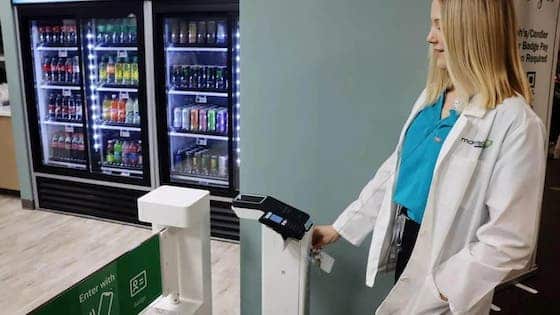Amazon’s Just Walk Out tech continues to find new use cases. The latest involves employee entry… as in authenticating that you actually work at a place before letting you in the building. More importantly, Amazon is extending this framework to transactional zones within enterprise spaces, such as cafeterias.
Backing up for those unfamiliar, Just Walk Out sits under Amazon’s retail as a service (RaaS) play. After incubating the retail logistics and streamlining technology in Amazon Go stores, it started rolling it out to third parties, including Starbucks, quick-service restaurants like Panera, and event venues.
As part of this play for a cashier-less world, Amazon also has the Amazon One palm scanner which customers swipe at store entrances or checkout terminals. The idea is to bring operational efficiencies and logistical streamlining to retail or any other space where people enter, exit or pay for things.
Whether it’s walking out of a store and avoiding checkout aisles, or getting let into a sporting event, the common thread is to authenticate individuals. That could be in service of paying for something or validating that someone is who they say they are. This framework casts a wide net for use cases.
Programs & Policies
That brings us back to the latest development. As noted, Amazon is applying Just Walk Out to enterprise spaces, which can include corporate or industrial settings. Importantly and intelligently, It’s doing this by piggybacking on existing infrastructure, which translates to tried-and-true employee badges.
For example, associates at a given company can quickly grab and pay for lunch by scanning their employee badges. On the back end, the badge is linked to the company’s payroll system so that they can deduct funds or allocate benefits/perks in whatever way aligns with their programs and policies.
This could be smart as it doesn’t require logistical retooling, and builds on existing infrastructure and comfort levels. Amazon simply adds some middleware to tie it all together. As part of its system, employees and employers can also track purchases, receipts, or account balances in one place.
Moreover, the use case could be well-received in settings such as hospitals, where healthcare professionals are always short on time. Fitting value proposition aside, this is a logical direction for Amazon, which aligns with its ongoing high-stakes moves into the massive healthcare vertical.
In fact, Just Walk Out’s enterprise debut will happen at a hospital. The first one will be St. Joseph’s Chanler Hospital in Savanahh Georga. There, Amazon has worked closely with healthcare automation provider CBORD (again, existing infrastructure) to integrate Just Walk Out into the hospital store.
Everything as a Service
Back to Amazon’s RaaS ambitions, a key question is why? There, the answer is multifaceted but also simple. If we follow the money, RaaS is a move towards revenue diversification, which is the name of the game for maturing tech giants that operate on such a large scale, when growth is harder to find.
This drives big bets like going into healthcare (One Medical), as noted. Massive vertical conquests like this are required to move the needle for percentage revenue growth. That’s the downside of having such a massive revenue base. Other examples include Apple’s moves into entertainment and wearables.
For Amazon, RaaS is also logical because it follows the playbook of one of the most successful products the tech world has seen in the past decade: AWS. Like RaaS, it was incubated internally before spinning out as an enabling tech for tech businesses everywhere. RaaS so far has followed a similar path.
That’s why Amazon Go stores were always just a test bed. Amazon had no interest in running convenience stores. It was all about tuning the platform to live on as a service (which we predicted). Now that service has an additional dimension in unlocking enterprise markets. Don’t expect it to stop there.



